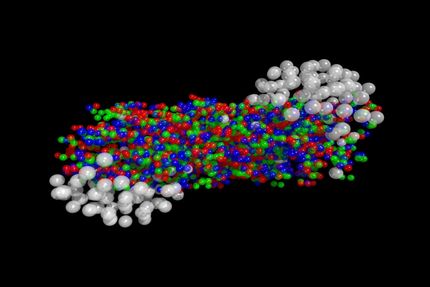Getting a grip on exotic atomic nuclei
Advertisement
A new model describing atomic nuclei, proposed by a physicist from the University of Warsaw Faculty of Physics, more accurately predicts the properties of various exotic isotopes that are created in supernova explosions or inside nuclear reactors.
Even with modern accelerators and detectors we are still unable to create and observe many exotic isotopes that are formed in supernova explosions and inside nuclear reactors. As a result, a significant number of atomic nuclei still remain unstudied. Predicting some of their properties has just become easier, thanks to a new model describing atomic nuclei recently published by Dr. Krzysztof Miernik from the Faculty of Physics at the University of Warsaw (UW), Poland.
"These days, when just the list of authors contributing to a publication in nuclear physics sometimes runs nearly as long than the main text of the article itself, papers written by a single author are a true rarity. In this case, the paper is all the more unusual in that a new theoretical model has been presented by an experimental physicist," says Prof. Tomasz Matulewicz, director of the Institute of Experimental Physics at the UW Faculty of Physics.
Modern theoretical models of atomic nuclei fall into two groups: microscopic and phenomenological. Microscopic models try to describe nuclei using the equations of quantum mechanics, which can only be done for nuclei with relatively small numbers of protons and neutrons. Phenomenological models, in turn, do not concern themselves with the details of the underlying physical phenomena, but instead try to identify more general, statistical correlations between various nuclei.
"Descriptions derived from the most basic quantum-mechanical principles can be devised only for simple nuclei, containing no more than a dozen-odd particles. Statistical models, on the other hand, work well only when dealing with truly large datasets. And so there's a problem, because the number of protons and neutrons in most atomic nuclei is somewhere in between: large enough to make precise description impossible in practice, but at the same time small enough that statistical description remains imprecise," Dr. Miernik explains.
Modern physics recognizes four fundamental forces: the gravitational, electromagnetic, strong nuclear, and weak nuclear forces. Gravitation operates between particles that have mass, thereby shaping the Universe on cosmic scales. Electromagnetism binds negatively charged electrons to positively charged atomic nuclei, forming atoms, which we can see thanks to photons, which are carriers of electromagnetism. The strong nuclear force "glues" quarks together to form protons and neutrons, the main components of atomic nuclei. Compared to these other three forces, the weak nuclear force might seem insignificant.
"Nothing could be further from the truth! Weak nuclear forces play a very important role: it is thanks to them that certain nuclear particles can change into others. If it were not for the weak force, we would not have so many chemical elements in the Universe," Dr. Miernik says.
Stars are the main factories churning out various elements in the Universe. However, the thermonuclear reactions taking place within them are unable to produce atomic nuclei heavier than iron. Fortunately, thanks to the weak force, something called beta minus decay sometimes takes place within a nucleus: a neutron turns into a proton plus two other particles (an electron and an electron antineutrino, which quickly leave the nucleus). As a result of beta minus decay, the number of protons in an atomic nucleus increases, in each case giving rise to a new chemical element.
"Interesting things happen not only during beta minus decay itself, but also afterwards. The new nucleus may be in an excited state. If it has a relatively even ratio of neutrons to protons, it will probably relase the excess energy by simply emitting gamma radiation. But if the neutrons in a nucleus significantly outnumber the protons, it may emit a neutron. We therefore have a beta decay, followed by a delayed neutron emission," Dr. Miernik explains.
Delayed proton emission is a process of important significance in astrophysics. Supernova explosions release large quantities of neutrons, some of which are captured by atomic nuclei. One of the main pathways producing new elements, responsible for the creation of more or less half of the isotopes heavier than iron, involves precisely this beta minus decay combined with delayed neutron emission.
"Our lack of knowledge about the exotic atomic nuclei that get formed in supernova explosions poses a true obstacle to fully understanding the processes occurring there," Dr. Miernik says.
Delayed neutron emission is also of importance here on Earth: it makes it relatively easy to monitor the progression of nuclear reactions in atomic reactors. If, during uranium decay, all the neutrons were to be released immediately, there would always be a chain reaction, leading to a nuclear explosion. Fortunately, that is not the way things happen. Although just one neutron out of every few dozen emitted by decaying uranium gets emitted with a delay, this small ratio is sufficient for the reaction to be controlled.
Uranium decay can give rise to around 270 different atomic nuclei emitting delayed neutrons. However, actually measuring their properties is a tough task. Because of their short lifetimes, most of these atomic nuclei need to be created artificially. Moreover, detecting the emitted neutrons, which carry information about how the decay happened, requires the use of expensive and inefficient detectors. As a consequence, modern physics has identified the properties of little more than one-third of all the atomic nuclei in this group.
"Let's look at this from the structural engineer's perspective. If certain atomic nuclei are going to be produced inside a reactor, we would like to know which ones, and how they will behave. A new nucleus could be, for instance, an isotope of krypton, which is a noble gas, or it could just as easily be rubidium, an alkali metal, which will behave completely differently inside the reactor," Dr. Miernik says.
The model of delayed neutron emission which Dr. Miernik has proposed is an extension of the statistics-based models. His key idea was to create a systematic analysis method based on one of the parameters (called nuclear level density) so that the predictions of the model correspond as well as possible to experimental measurements. The model so devised makes it possible to systematize the atomic nuclei known to date, as well as to anticipate the properties of exotic nuclei that have not yet been studied.
Like every new model, this one will also have to undergo persistent experimental verification. For the time being it has passed a preliminary test, in which the number of number of known atomic nuclei was artificially reduced, and the model's predictions based on this restricted dataset were compared to the known parameters of the nuclei that had been eliminated. Dr. Miernik expects the first measurements of new atomic nuclei, that can be used to verify the accuracy of the model, to come from experiments that will soon get underway at the RIKEN Nishina Center in Japan.


































































